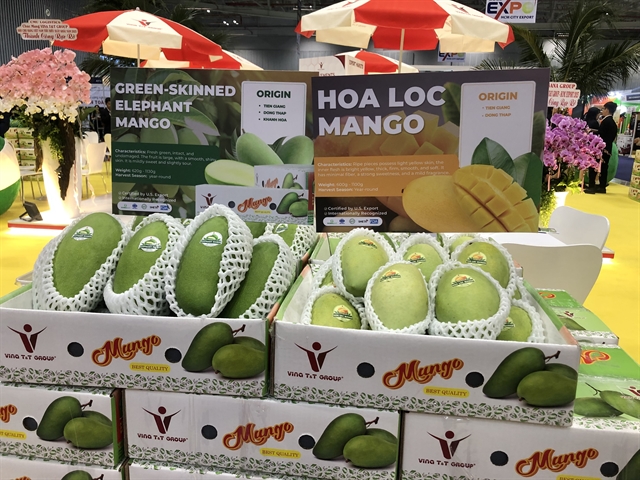 Economy
Economy


|
| Nguyễn Thanh Bình, chairman of the Việt Nam Fruit and Vegetable Association. |
Fruit and vegetable exports are expected to fetch US$7.6–8 billion this year on the back of strong demand for durian and steady demand generally in key markets.
But rising US tariffs, fierce competition and high logistics costs pose challenges, Nguyễn Thanh Bình, chairman of the Việt Nam Fruit and Vegetable Association, tells the media and discusses measures to sustain growth.
How did Việt Nam’s fruit and vegetable exports fare in the first seven months of 2025 and what is the outlook for the rest of the year?
As of July 31 Việt Nam’s total fruit and vegetable exports were worth around US$3.9 billion, down 0.3 per cent from the same period in 2024. The recovery in durian exports is one of the main factors putting Việt Nam’s fruit and vegetable exports back on the recovery track.
In recent years Vietnamese durian has firmly established its position, particularly in the Chinese market. With stable demand and high added value, durian has become a pillar of the fruit and vegetable industry.
The main durian harvest season in the southeast and Central Highlands is underway and will last until November. This is a decisive period for output and exports in the remaining months of the year.
I am confident Việt Nam’s fruit and vegetable sector can achieve its full-year target.
The Vietnam Fruit and Vegetable Association has set an export target of US$8 billion in 2025, while the Ministry of Agriculture and Environment projects around $7.6 billion. In my view, the range of $7.6–8 billion is entirely achievable. The necessary condition is to maximise the growing season for durian and other key fruits. The other condition is that major markets, particularly China, do not impose additional technical barriers on quarantine or quality. If these two conditions are met, the export target is well within reach.
Since August the US has imposed a 20 per cent reciprocal tariff on Vietnamese fruits and vegetables. How do you assess the impact of this policy?
The US is Việt Nam’s second largest fruit and vegetable export market after China. In the first seven months of 2025, exports to the US grew by more than 60 per cent year-on-year. The US share of total exports also rose from 5 per cent in 2024 to over 8.4 per cent this year. Though the proportion remains modest, the US is a very important market, serving as a benchmark for quality, safety, reputation, and compliance capacity of Vietnamese exporters.
However, a 20 per cent tariff is extremely high for fruits and vegetables, which are inherently low-margin agricultural products. The tariff will erode profits for both farmers and businesses, and some companies may even be forced to suspend operations. The impact will spread across the entire value chain, affecting farmers, collectors, processors, and exporters alike.
This tariff also reduces Việt Nam’s competitiveness compared to US-grown produce, which benefits from favourable local conditions, as well as products from South American countries, which enjoy geographical proximity and lower logistics costs, not to mention lower tariff rates. Consequently, Việt Nam’s fruit and vegetable exports to the US will inevitably face big challenges.
Given this situation, what solutions would you propose to sustain exports to the US?
The most viable solution is to shift focus towards processed products. Because the US is geographically distant, fresh exports rely heavily on air freight, which significantly inflates costs.
In contrast, processed goods can be shipped by sea, reducing costs, extending shelf life and making it easier to comply with strict US food safety regulations.
Moreover, deep processing allows businesses to better control pesticide residues, preservatives and traceability, all factors of great concern to US authorities and consumers.
By investing in processing, we can turn tariff disadvantages into new competitive strengths while enhancing the added value of Vietnamese fruits and vegetables.

|
| Mangoes on display at a recent exhibition in HCM City. Việt Nam’s fruit and vegetable exports are expected to fetch US$7.6–8 billion this year. — VNS Photo Xuân Hương |
Beyond the US, which other markets should Việt Nam prioritise?
When exports to the US encounter difficulties, it is essential to quickly pivot to alternative markets. That is a given because Vietnamese farmers and enterprises cannot afford to halt production. Both the association and the Government have emphasised market diversification as a strategic direction.
We must continue to leverage our traditional markets such as China, the EU, Japan, and South Korea, all of which still offer significant growth potential. At the same time we should explore new opportunities in the Middle East, Africa and India. Although India is not an entirely new market, it still offers room for expansion.
In short, Vietnamese businesses need to both consolidate traditional markets and proactively develop new ones while seeking government support to improve market access.
Logistics costs remain a major burden for the sector. How do you view this issue?
Việt Nam’s logistics costs are among the highest in the region. For fruits and vegetables, logistics account for more than 30 per cent of product cost, much higher than in other industries, where the rate is typically under 30 per cent.
The main reason is the high reliance on fresh exports to distant markets such as the US, Europe and South Korea.
The association has repeatedly proposed that the Government invest more heavily in logistics infrastructure, especially cold storage, preservation centers and both sea and air transport systems. Improved logistics will help extend the shelf life of agricultural products, lower costs and ultimately strengthen the competitiveness and sustainability of Vietnamese exporters. — VNS




